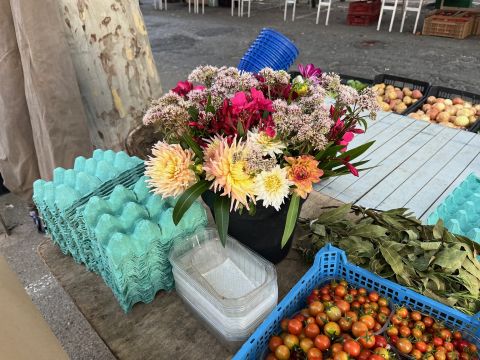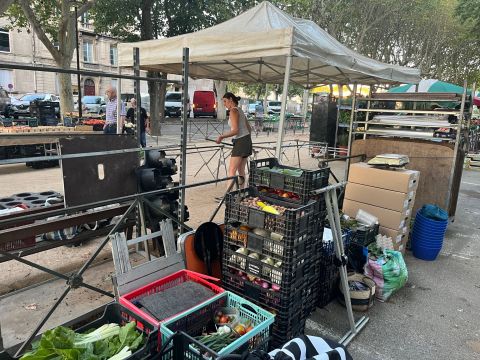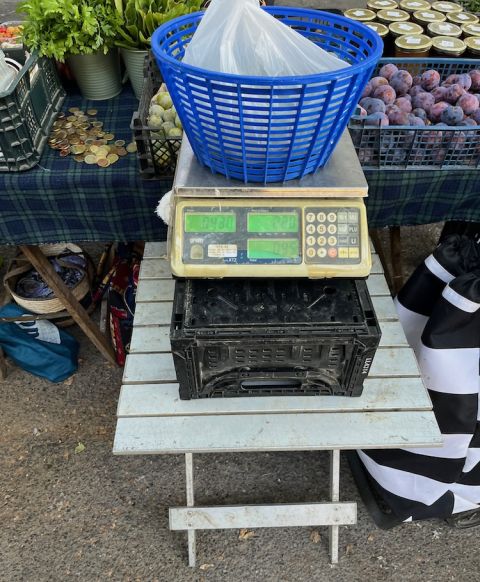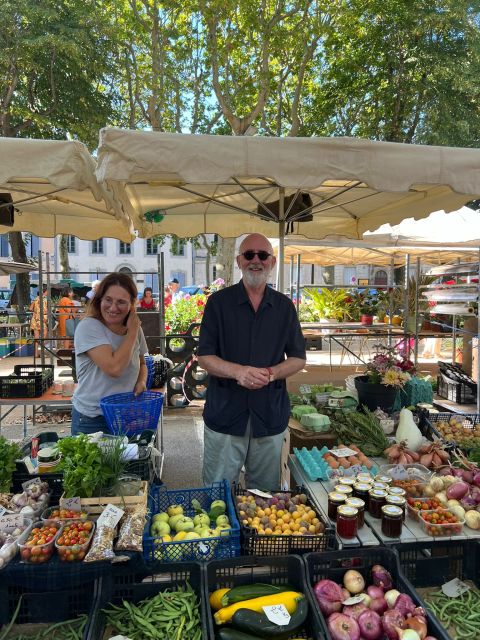At a southern French market

Above, Nick's new boss getting ready for a day's trading.
Like so many others, I am a creature of habit.
And one habit, for the past 25 years at least, has been that when we are in the Languedoc over the summer I wake at 7 am every Saturday to get dressed, unload the dishwasher, make JR a cup of tea and finally load my shopping bags – nowadays more of a shopping trolley – into the car before heading off to the food market in Carcassonne.
I arrive by 8 am, park with relative ease, then walk the half-mile to the market. In the old days this took place in the Place Carnot, a square surrounded by cafes in the middle of town. It continues here on a smaller scale on Tuesdays and Thursdays but on the much busier Saturdays it is held just outside the city ramparts where there is less atmosphere but definitely more space.
The market stalls are lined up in four relatively straight lines with producers mixed up throughout. At the western end there are plenty of stalls devoted to clothes, shoes, deodorants, perfumes and general bric-a-brac.
But as you leave the purple bras and cheap cosmetics you enter the area dominated by those selling produce – produce that strikes a Londoner as exceptionally high quality, and keenly priced to boot. First is a stall selling bread and pastries before a much larger stall selling olives, nuts, confit lemons, inexpensive olive oil and superb salted cashew nuts (the stall I wrote about in 2019). Then there is a large, very varied stall where the stallholder has a commanding presence with big, rounded shoulders, enormous hands, massive moustache and occasionally a big smile.
Then there is a run of specialist stalls. A man selling goats’ cheeses and goat fromage blanc. A stall where a couple sell the best nectarines, apricots, peaches and, last week, especially delicious raspberries. He says very little and she talks for them both. Then there is the flower stall where, at the outset of every stay, I buy a verveine (lemon verbena) plant for tisanes over the summer.
Next, a man selling nothing but honey and another who pours raw milk from a dispenser into your empty bottles (or charges an extra euro if you arrive empty-handed). Next to him is a stall selling strawberries and raspberries and next door is another large stall that sells olives, nuts and excellent plaited heads of garlic. This is where the stallholder runs a side business dispensing shots of espresso from a pod machine. One of the big disadvantages of holding the market here, as opposed to the Place Carnot, is the absence of cafés where you can meet your friends and take a well-earned rest.
Further along there is quite an international mixture of stalls. Near the eastern end of the market is one run by the Vietnamese woman who makes the best spring rolls, riz au poulet and prawn crackers which I often buy for Saturday lunch. Her neighbours are a couple of very French stalls, one selling various pork products, the other roast chickens. But there is also an increasing stretch of stalls run by North Africans selling mint, parsley and coriander by the huge bunch for a euro each. Arabic was the first language I heard as I walked into the market last Saturday. Two elderly men, both stallholders, were deep in conversation.
The stall I head to – and have done for the past 20-odd years – is in the middle. Why I first stopped here I can no longer remember. Was it their array of flowers or perhaps their home-made apricot jam? Or perhaps it was because of its former location in the corner of the original market that led to the covered market where meat and fish are sold. I am not sure. But I first stopped here when the parents were in charge whereas today it is their ever-smiling daughter Véronique Andraud, pictured at the top of this article. Having spent my usual €30–€40 with her one Saturday morning on a basketful of flowers, cucumbers, the sweetest local sucrine lettuce, jams, small potatoes and several bunches of carrots, I asked her whether I could help her the following Saturday.
Her response was to laugh out loud, then to ask, ‘Pourquoi?’ When I explained that as someone who had bought a lot of produce in my time, I had always wanted to try it, she seemed to understand before rapidly agreeing. ‘Bien sûr’, she smiled.
I must reinforce at this point quite how important suppliers are to all chefs, whether professional or amateur. It had become a myth by the early 1980s that professional chefs visited the markets early in the morning themselves. By then they had come to rely on an array of trusted suppliers. Several of those who supplied me then at L’Escargot remain friends to this day. Buying produce from somebody who has grown or produced it provides an incontrovertible basis for friendship.
As instructed, I arrived at 7 am the following Saturday and the van had already been unloaded. There were boxes and cartons everywhere and a lot of Andraud’s ‘infrastructure’: supports; flimsy bits of old table tops that somehow fit together; and umbrellas to provide the vital shade. Then there were the cartons and cases of produce plus the jams in two sizes. Finally, there were her usual flowers, in much-reduced quantity this year thanks to the prolonged drought.
All of this had to be moved about 10 metres from the back to what would soon become the front of the stall. This, despite Véronique’s warnings, became my task for the next 15 minutes until all the produce had been arranged in an order that pleased her (the heaviest to move was undoubtedly the box containing the larger jars of jam). Then it was time for more detailed instruction.
Most important were the scales which have to be correct and set to weigh zero with the blue plastic container sitting on them. Then there was the money. ‘Coins here, small notes by the scales, and larger notes, particularly €50 notes (of which there were to be far more than I expected), here’, instructed Véronique, slapping the back pocket of her jeans. ‘Now’, she said with a look of satisfaction, ‘Coffee?’
Clasping a €2 piece we set off past numerous stalls still being set up to the man who sells olives and garlic who doubles as a barista. It was over the espressos that Véronique told me that her parents had had a stall in Carcassonne for 50 to 60 years; that the produce came from their farm, a 40-minute drive from Carcassonne. And that she loved the market, her customers – many of whom she had inherited from her parents – and her fellow stallholders. All this despite the 5 am wake-up call.
It was now about 7.50 am and the first customers were drifting by, but it was at this moment that I was left on my own. Muriel, the woman who runs the stall opposite, had fallen ill and had left her young daughter in charge. She looked even more terrified than I was. It was Véronique’s duty to help her out and for the next half an hour she would disappear from her own stall and dispense advice.
Meanwhile I survived and was eventually given the role of ‘Captain of Eggs’. Véronique’s eggs proved extremely popular with her customers, many of whom arrived clutching their empty egg boxes to be refilled. I had been told sternly that one elastic band was sufficient to close a carton of six eggs. Véronique chatted, handled everything and then turned to me when she needed a full box of eggs. And so the morning passed.
What did I learn? That markets such as this one are hardly lucrative affairs, with most stallholders not generating that much in sales nor in fact gross profit. Véronique charges just €2.40, for example, for a jar of her delicious, home-grown and homemade apricot jam – second only in quality to my sister’s as the best in the world.
I also learned that, by and large the customers are elderly and don’t buy in large quantities. I was introduced to one couple by Véronique because, as she put it, ‘they were good friends with my parents’. It is the social aspect of these markets that will, I hope, ensure their longevity.
I was struck by the politesse on display everywhere. No purchase began without a ‘Bonjour’; every transaction was a prelude to a conversation; and no payment was concluded without a ‘Bonne journée!’ So in the manner of the market, may I conclude with an ‘À bientôt’ and ‘Merci, Véronique’.
Every Sunday, Nick writes about restaurants. To stay abreast of his reviews, sign up for our weekly newsletter.
Become a member to view this article and thousands more!
- 15,426 featured articles
- 274,442 wine reviews
- Maps from The World Atlas of Wine, 8th edition (RRP £50)
- The Oxford Companion to Wine, 5th edition (RRP £50)
- Members’ forum
- 15,426 featured articles
- 274,442 wine reviews
- Maps from The World Atlas of Wine, 8th edition (RRP £50)
- The Oxford Companion to Wine, 5th edition (RRP £50)
- Members’ forum
- Commercial use of our Tasting Notes





